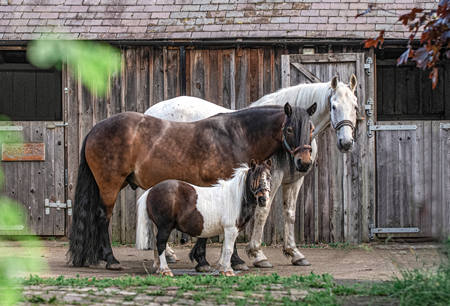Every Horse Needs a Worm egg count Every Horse, Every Size, Every Season


Every horse needs a worm egg count.
Getting started is easier than you think!
No matter the size, breed, or workload of a horse, all equines are at risk of internal parasites. Miniature ponies, leisure horses, performance athletes, and retired companions alike can all carry worm burdens, and managing these effectively is key to their wellbeing. It isn’t just about keeping your horse healthy; it’s also key to protecting the efficacy of worming medications for the future.
Special Offer!
Save 5% on Season Packs by entering YOURHORSE at checkout
Why Worm Egg Counts Are Essential
A targeted approach prevents unnecessary use of wormers, reducing the risk of resistance and is the gold standard for modern parasite control, ensuring your horse only receives treatment when needed.
When should you test?
Parasite control isn’t a one-and-done process. Regular WECs throughout the grazing season are essential for staying ahead of parasites. Horses that consistently have low counts may not need frequent worming, while those with high counts may require closer monitoring.
In addition to WECs, include tapeworm tests every six months. Tapeworms don’t show up in standard WECs, so an EquiSal saliva test is needed to detect them.
Late autumn/winter is the time to consider encysted small redworm larvae. These don’t appear in WECs either, so a blood test or proactive treatment for this stage of the lifecycle may be necessary, depending on your horse’s risk level.
WHY ONE IS NOT ENOUGH! A suggested programme
A mature, healthy horse can follow a very simple pattern of testing and dosing. There are two tests that should form the basis of an effective targeted worm control programme – worm egg counts for redworm and roundworm and the EquiSal saliva test for tapeworm. Both tests give statistical results for the levels of parasites present that can be used to determine whether the horse needs treatment or not. You may also need to consider bots, pinworm, lungworm and liver fluke in your programme if you suspect a problem.
Veterinary advice recommends that all horses are regularly tested throughout the grazing season. A tailored worm control plan should include:
- Worm egg counts every 8-12 weeks to monitor strongyle egg shedding.
- Targeted tapeworm testing every six months, as tapeworms do not show in WECs.
- A risk-based approach to encysted small redworm, assessed in winter to either test and/or treat.
- Good pasture management, including regular poo picking and sensible grazing strategies.
The following programme is a good basis for a healthy adult horse:

Foals, youngsters, neglected or older horses will require more attention and frequent testing to ensure any parasite burden doesn't get out of hand. Determine your horse's risk profile here. This allows us to devise a tailored parasite control plan for the year ahead, ensuring that testing and treatments are aligned with your horse’s specific needs.
Once you’ve got the result, what next?
Worming is only required if the tests indicate infection above a certain level. An explanation will be given by the laboratory to help you decide whether to worm or not. Alternatively you can ask an SQP OR vet for advice, who will want to discuss your horse’s test results in the context of worming history and general health, and can then advise on an appropriate wormer to use if this is required.
Pasture Management Matters
Testing alone won’t control parasites; good pasture management is equally important.
- Poo pick regularly: Remove droppings from fields at least twice a week to reduce the number of infective larvae.
- Avoid overstocking: Overstocked paddocks increase the risk of worm exposure.
- Rotate grazing: Resting or rotating fields helps break the lifecycle of parasites.
Good parasite control is an essential part of your horse care routine; take the first step toward smarter, more sustainable parasite management.
ANY QUESTIONS ABOUT WHERE TO START WITH YOUR OWN HORSE?
Subscription Service Or Season Pack?
At Westgate Labs, we understand that responsible parasite control is essential for the health and wellbeing of your horse. With this in mind, we offer two comprehensive service options designed to make testing easy and effective: the 4Count Plus Season Pack and our All Seasons Subscription Service. Which one suits you best?
Compare Our Services and take advantage of exclusive Your Horse offers!
Discounted Season Packs
Save 5% off a 4Count Plus Season Pack – £85.50 (RRP £90.00)
- Includes 4 x worm egg counts and 2 x EquiSal tapeworm tests
- All test kits are provided upfront in a handy wallet for the year ahead
- Single postage fee
- Optional email reminders every 3 months for worm egg counts and every 6 months for tapeworm tests
- Additional tests need to be purchased separately
In addition we also offer a 4Count Season Pack that excludes the 2 x EquiSal tapeworm tests and also offers a refill option. On offer at £37.05 (RRP £39)
To redeem this discount enter the offer code YOURHORSE at checkout. Offer ends 31.04.2025.
First month FREE on Subscription Plans
All Seasons Subscription – £9.99 per month
- Rolling plan that spreads the cost monthly for convenience
- Kits sent to you when needed – no need to track your schedule
- Full advisory support, including guidance on encysted small redworm management
- Free reduction test if your winter worm egg count is positive
- £25 annual test allowance for additional testing (e.g. pinworm or sand tests)
- Includes postage costs for all test deliveries
- Cancel anytime after the first three months
While the subscription service costs slightly more, it offers added convenience, postage coverage, and additional benefits that ensure complete peace of mind.
We also offer Essential Care Subscription plans starting from only £5.75 per month (that exclude EquiSal tapeworm testing).
Your Horse readers can take advantage of their first month free when taking out a new sub on the link below:

